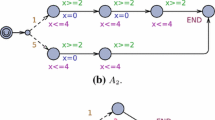Abstract
This paper proposes to enhance compositional verification of the nonblocking property of discrete event systems by introducing annotated automata. Annotations store nondeterministic branching information, which would otherwise be stored in extra states and transitions. This succinct representation makes it easier to simplify automata and enables new efficient means of abstraction, reducing the size of automata to be composed and thus the size of the synchronous product state space encountered in verification. The abstractions proposed are of polynomial complexity, and they have been successfully applied to model check the nonblocking property of the same set of large-scale industrial examples as used in related work.

Similar content being viewed by others
References
Åkesson K, Fabian M, Flordal H, Malik R (2006) Supremica—an integrated environment for verification, synthesis and simulation of discrete event systems. In: Proc. 8th int. workshop on discrete event systems, WODES’06, Ann Arbor, MI, pp 384–385
Cassandras CG, Lafortune S (1999) Introduction to discrete event systems. Kluwer, Norwell
Clarke Jr EM, Grumberg O, Peled DA (1999) Model checking. MIT Press, Cambridge
De Nicola R, Hennessy MCB (1984) Testing equivalences for processes. Theor Comput Sci 34(1–2):83–133. doi:10.1016/0304-3975(84)90113-0
Eloranta J (1991) Minimizing the number of transitions with respect to observation equivalence. BIT 31(4):397–419
Feng L, Wonham WM (2008) Supervisory control architecture for discrete-event systems. IEEE Trans Automat Contr 53(6):1449–1461
Fernandez JC (1990) An implementation of an efficient algorithm for bisimulation equivalence. Sci Comput Program 13:219–236
Flordal H, Malik R (2006) Modular nonblocking verification using conflict equivalence. In: Proc. 8th int. workshop on discrete event systems, WODES’06, Ann Arbor, MI, pp 100–106
Flordal H, Malik R (2009) Compositional verification in supervisory control. SIAM J Control Optim 48(3):1914–1938. doi:10.1137/070695526
Hoare CAR (1985) Communicating sequential processes. Prentice-Hall, Englewood Cliffs
Kumar R, Shayman MA (1994) Non-blocking supervisory control of nondeterministic discrete event systems. In: Proc. American control conf, Baltimore, MD, pp 1089–1093
Malik R, Streader D, Reeves S (2006) Conflicts and fair testing. Int J Found Comput Sci 17(4):797–813
Milner R (1989) Communication and concurrency. Series in computer science. Prentice-Hall, Englewood Cliffs
Nuutila E (1995) Efficient transitive closure compuation in large digraphs. PhD thesis, Laboratory of Information Processing Science, Helsinki University of Technology, Finland
Olderog ER, Hoare CAR (1986) Specification-oriented semantics for communicating processes. Acta Inform 23(1):9–66
Pena PN, Cury JER, Lafortune S (2009) Verification of nonconflict of supervisors using abstractions. IEEE Trans Automat Contr 54(12):2803–2815
Ramadge PJG, Wonham WM (1989) The control of discrete event systems. Proc IEEE 77(1):81–98
Rensink A, Vogler W (2007) Fair testing. Inf Comput 205(2):125–198. doi:10.1016/j.ic.2006.06.002
Su R, van Schuppen JH, Rooda JE, Hofkamp AT (2010) Nonconflict check by using sequential automaton abstractions based on weak observation equivalence. Automatica 46(6):968–978. doi:10.1016/j.automatica.2010.02.025
Ware S, Malik R (2010) Compositional nonblocking verification using annotated automata. In: Proc. 10th int. workshop on discrete event systems, WODES’10, Berlin, Germany, pp 374–379
Ware S, Malik R (2011) A state-based characterisation of the conflict preorder. In: Proc. 10th int. workshop on the foundations of coordination languages and software architectures, FOCLASA 2011, Aachen, Germany, pp 34–48. doi:10.4204/EPTCS.58.3
Author information
Authors and Affiliations
Corresponding author
Rights and permissions
About this article
Cite this article
Ware, S., Malik, R. Conflict-preserving abstraction of discrete event systems using annotated automata. Discrete Event Dyn Syst 22, 451–477 (2012). https://doi.org/10.1007/s10626-012-0133-3
Received:
Accepted:
Published:
Issue Date:
DOI: https://doi.org/10.1007/s10626-012-0133-3




